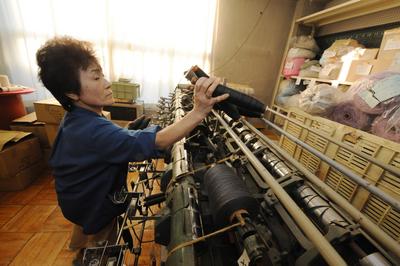Enter ‘Abenomics’. In 2013, growth spurted to a 4.1 per cent annual rate in the first quarter of 2013 and 3.8 per cent in the second quarter. Like others, I assume growth will continue to do well in the fall. Japan’s GDP is estimated to increase by 2.8 per cent in the fiscal year 2013.
But growth is expected to slow significantly in 2014 and beyond because the economic slack will be absorbed and government expenditures for the Tohoku earthquake reconstruction and public works will taper off. Also, households will accelerate purchases before the April 2014 consumption tax increase but consumption will subsequently slump late as the tax is raised.
But neither of Japan’s inflation or debt goals can be achieved unless Japan’s economy grows.
In his election campaign, Prime Minister Shinzo Abe announced an ambitious 10-year target of 2 per cent annual growth in real GDP.
Abe’s growth strategy scenario makes strong, perhaps unrealistic, assumptions. Growth depends on changes in labour inputs and increases in output per worker of 1.8 percent annually. Importantly, participation rates are projected to rise significantly — by 8–9 percentage points for women aged 30–34 and 7–8 percentage points for those aged 65 to 69.
Japanese people are already being encouraged to work for longer. Japan’s retirement age by custom and law is 60 for large companies and government officials. At 60, Japanese men can expect to live another 23 years, women another 29. Most are energetic, have skills, and want to continue working. Even now, about 70 per cent of new retirees either have their employment extended, are rehired by the same firm, or are introduced to another firm, often a subsidiary. Some 20 per cent of Japan’s seniors work, the highest rate in any developed country.
Companies are under pressure to extend the retirement age but are doing so slowly. In April 2013, the minimum age at which retirees can collect government pensions rose to 61; this is scheduled to increase by a year every three years to reach 65 by 2025.
An increase in participation rates would mean that the total number of workers would not decline significantly. But if present participation rates continue, decreases in the population and in its working age component would reduce the workforce by about 1 per cent annually.
But making it attractive for women and seniors to join the labour force is a huge challenge. Implementation depends on major new measures of deregulation, market liberalization and structural reforms — all strongly opposed by vested interests. These reforms make up the third arrow of Abenomics.
Embedded in Abe’s growth strategy is a significant tension between two fundamentally different policy approaches. One relies on markets: deregulation, increased domestic competition, and corporate reform. The other focuses on government industrial policy: incentives for growth industries, funding new technologies, and lagging-sector consolidation. While both approaches can help, reliance on markets should be key. Only deregulation and structural reforms will generate adequate incentives for firms to invest and people to work.
Both the government’s definition and implementation of its growth strategy are likely to be piecemeal. Two major programs for revitalizing the private sector are underway: the Trans-Pacific Partnership (TPP) trade negotiation, and restructuring and liberalization of the electric power industry.
For Japan, the most sensitive, and symbolically and substantively most important, issue in trade negotiations is agriculture. The TPP is an important policy mechanism for Japan to help achieve needed reforms because it will allow the government to blame hard decisions on intense foreign pressure (gai-atsu).
One of the most important TPP adjustment measures will be the time allowed for phasing out tariffs and other barriers. A phaseout of 10 years or more will be commensurate with the retirement of more Japanese farmers; 56 per cent of Japan’s rice farmers are 70 or older. While Japanese adjustments due to TPP will be substantively less onerous and difficult than its critics assert, nonetheless a successful TPP agreement will support and perhaps galvanise liberalising reforms in Japanese agriculture and other protected sectors.
A related challenge is revitalising Japanese businesses. Over the years since Japan’s bubble burst, businesses have paid off debt, trimmed employment through attrition, and upgraded facilities and equipment. The companies we know most about, the listed companies, overall are doing well with substantial increases in profits. They have strong cash flows from high depreciation allowances and huge cash balances since corporate savings rates are high even after ongoing real investment.
But it is difficult to know much about the myriad of small and medium enterprises (SMEs). Quite a few are strong players domestically and even globally. But at least 50,000 are estimated as being in dire straits, kept alive only by loan rollovers by creditors unwilling to record losses by forcing them into bankruptcy. This comes at a significant cost. Today zombie companies in various sectors weaken healthy firms and contribute to resource misallocation. Government support for bank loans to zombie companies ended in March 2013, and banks are gradually forcing them to close.
Achieving Abe’s GDP growth target of 2 per cent requires major structural changes in the Japanese economy, including further major deregulation and incentives for growth industries, consolidation in uncompetitive industries, and closing distressed SMEs. The challenge for the Abe government is to implement these policies wisely, strongly and well.
Hugh Patrick is Director of the Center on Japanese Economy and Business and Robert D Calkins Professor of International Business Emeritus at Columbia University, New York.
This is the second article in a three-part series.


Interesting to see discussion of increasing labor market participation for older employees and women. How is this to be encouraged and what are the odds of it actually succeeding?